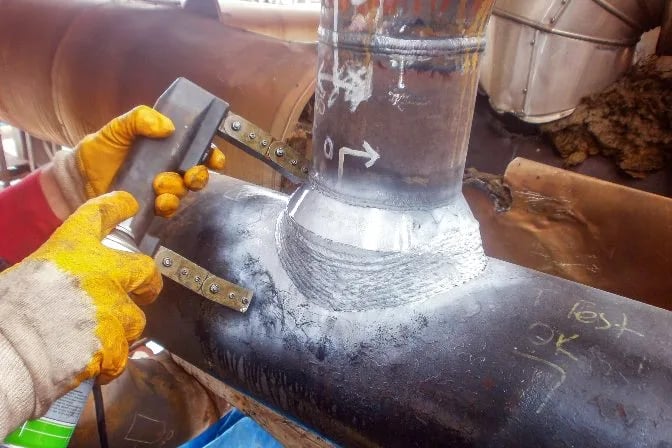Comprehensive Summary of Pipe Welding Assessment Treatments
Pipeline welding inspection treatments play an important role in assuring that bonded connections fulfill rigid market criteria and specs. From precise pre-welding inspections to thorough post-weld evaluations, a well-defined assessment process is crucial for preserving the structural strength of pipelines.
Pre-welding Assessment Preparations
Prior to beginning the welding process, thorough pre-welding inspection prep work are vital to guarantee the integrity and top quality of the weld joint. These prep work involve a thorough exam of the materials to be bonded, the welding tools, and the work setting. By carrying out comprehensive pre-welding inspection prep work, potential concerns can be determined and resolved early on, leading to high-grade and trustworthy weld joints.
Welding Treatment Certification
Thorough pre-welding assessment preparations lay the structure for the crucial procedure of Welding Procedure Credentials, guaranteeing the honesty and quality of the weld joint. Welding Treatment Qualification (WPQ) is a crucial action in the welding process that entails screening and licensing welding procedures to assure they fulfill details requirements and needs. The WPQ process normally includes welding procedure spec growth, welding procedure certification testing, and paperwork of the outcomes.
During welding procedure specification development, necessary details such as the welding process, welding materials, joint style, and welding criteria are defined to create a detailed treatment. Ultimately, welding procedure certification testing is carried out to confirm the proposed procedure's integrity. This testing typically entails welding examination coupons that are subjected to various mechanical and non-destructive tests to evaluate the weld's high quality and adherence to the defined criteria.
In-process Weld Examination
Throughout the welding procedure, in-process weld examination plays an essential role in guaranteeing the high quality and stability of the weld joint - Pipeline Welding Inspection. This sort of assessment includes checking the welding criteria, examining the weld grain formation, and discovering any type of prospective problems or gaps as they happen. By conducting in-process weld inspections, welding operators can without delay resolve any kind of problems that may develop, consequently making certain and protecting against additional problems that the final weld fulfills the called for specs
Common approaches utilized for in-process weld evaluation include aesthetic evaluation, fluid penetrant testing, magnetic particle screening, ultrasonic screening, and radiographic testing. Aesthetic inspection is usually the primary step in the procedure, permitting examiners to visually analyze the weld for surface irregularities such as fractures, porosity, or incomplete blend. Advanced techniques like ultrasonic testing and radiographic screening provide thorough insights right into the internal framework of the weld, guaranteeing This Site that there are no surprise problems that can compromise the weld joint's toughness and integrity. Generally, in-process weld evaluation is crucial for preserving the top quality and reliability of bonded pipes.
Non-destructive Screening (NDT)
Non-destructive Testing (NDT) is a vital approach used in pipeline welding evaluation to examine the honesty of weld joints without causing damage to the welded structure. By using numerous NDT strategies, assessors can assess the high quality of welds and determine any type of issues or suspensions that may jeopardize the architectural strength of the pipe. Usual NDT approaches made use of in pipe welding inspection include look here Radiographic Testing (RT), Ultrasonic Testing (UT), Magnetic Particle Evaluating (MPT), Fluid Penetrant Testing (LPT), and Visual Testing (VT)
RT entails the usage of X-rays or gamma rays to produce images of the interior structure of the weld, allowing assessors to discover defects such as porosity, splits, or insufficient fusion. In addition, VT includes visual examination of welds to determine any noticeable flaws.
Post-weld Inspection and Documents


Documents of post-weld evaluation searchings for is vital for maintaining high quality control documents and making sure conformity with market criteria and policies. Thorough reports must consist of info concerning the inspection techniques made use of, the location and nature of any type of defects discovered, and any kind of corrective actions taken - Pipeline Welding Inspection. Correct documentation not only works as a document of the weld's quality however additionally help in future maintenance and assessment processes
Final Thought

In verdict, pipeline welding assessment procedures play an important duty in guaranteeing the top quality and integrity of welds. From pre-welding assessments to post-weld documents, each step is vital in keeping the safety and effectiveness of pipes. By adhering to established procedures and carrying out extensive examinations, possible issues can be identified and dealt with prior to they bring about pricey repairs or failures. In general, adherence to appropriate assessment methods is vital to the success of pipe welding projects.
From precise pre-welding assessments to detailed post-weld evaluations, a well-defined evaluation process is essential for maintaining the architectural sturdiness of pipes. By performing in-process weld assessments, welding operators can quickly address any concerns that might develop, thus avoiding further issues and making certain that the last weld meets the called for requirements.
Typical methods made use of for in-process weld evaluation include aesthetic evaluation, fluid penetrant screening, redirected here magnetic particle screening, ultrasonic testing, and radiographic screening.Non-destructive Screening (NDT) is a crucial approach utilized in pipe welding assessment to evaluate the honesty of weld joints without triggering damages to the welded framework. Post-weld evaluation involves different methods to examine the welds for defects, consisting of visual assessment, dye penetrant testing, magnetic fragment testing, ultrasonic screening, and radiographic testing.